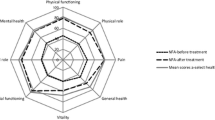Abstract
A validated quality of life (QOL) measure, the SF-36 questionnaire, was used to assess patients' perception of the impact of a pituitary adenoma, prior to treatment, on his or her physical and mental functioning. Of 270 new patients evaluated for pituitary disease at the University of Virginia Pituitary Clinic, 168 met the criteria for inclusion (pituitary hormone hypersecretion and/or pituitary adenoma) into this prospective study. Results of the SF-26 questionnaire in 36 patients with acromegaly, 42 patients with Cushing's disease, 39 patients with a prolactinoma and 51 patients with a non functioning macroadenoma prior to treatment were compared with those of the normal population; a comparison of results among patients with different types of pituitary adenomas was also performed. Patients with a pituitary adenoma had a significantly decreased QOL compared with the normal population in both physical and mental measures (p < 0.05). There were different degrees of perceived impairment depending on the type of pituitary adenoma. Patients with acromegaly had impairment in measures of physical function while patient with Cushing's disease had impairment in all but one measures compared with the normal population and with patients with other types of pituitary adenomas. Patients with a prolactinoma had impairment in mental measures and patients with a non-functioning adenoma had impairment in both physical and mental measures compared with the normal population. Patients with a pituitary adenoma have an impaired quality of life that should be routinely assessed in conjunction with endocrine and anatomic studies before and after treatment.
Similar content being viewed by others
References
Hall WA, Luciano MG, Doppman JL, Patronas NJ, Oldfield EH. Pituitary magnetic resonance imaging in normal human voluntees: Occult adenomas in the general population. Ann Intern Med 1994;120:817-820.
Burrow GN, Wortzman G, Rewcastle NB, Holgate RC, Kovacs K. Microadenomas of the pituitary and abnormal sellar tomograms in an unselected autopsy series. N Engl J Med 1981;304:156-158.
Laws ER, Vance ML Radiosurgery for pituitary tumors and craniopharygniomas. Neurosurg Clin N Amer 1999;10:327-336.
Klibanski A, Zervas NT. Diagnosis and management of hormone-secreting pituitary adenomas. N Engl J Med 1991;324:822-831.
Freda PU, Wardlaw SL Diagnosis and treatment of pituitary tumors. J Clin Endocrinol Metab 1999;84:3859-3866.
Ware JE, Sherbourne CD. The MOS 36-item short-form health survey (SF-36). Med Care 1992;30:473-481.
Ware JE, Kosinski M, Dewey JE. How to Score Version Two of the SF-36 Health Survey. Lincoln, RI: Quality Metric Incorporated, 2000.
Sonino N, Fava GA, Fallo F, Boscaro M. Psychological distress and quality of life in endocrine disease. PsychotherPsychosom 1990;54:140-144.
Dorn LD, Burgess E, Dubbert B, Simpson S, Friedman T, Kling M, Gold PW, Chrousos GP. Psychopathology in patients with endogenous Cushing syndrome: Atypical or melancholic features. Clin Endocrinol 1995;43:433-442.
Sonino N, Fava GA, Raffi AR, Boscaro M, Fallo F. Clinical correlates of major depression in Cushing's disease. Psychopathol 1998;31:302-306.
Gotch PM. Cushing's syndrome from the patient's perspective. Endocrinol Metab Clin NAmer 1994;23:607-617.
Nagesser SK, van Seters AP, Kievit J, Hermans J, Krans HMJ, van de Velde CJH. Long-term results of total adrenalectomy for Cushing's syndrome. World J Surg 2000;24:108-113.
Pikkarainen L, Sane T, Reunanen A The survival and wellbeing of patients treated for Cushing's syndrome. J Intern Med 1999;245:463-468.
Sonino N, Boscaro M, Fallo F, Fava GA. A clinical index for rating severity in Cushing's syndrome. PsychotherPsychosom 2000,69:216-220.
Page RCL, Hammersley MS, Burke CW, Wass JAH. An account of the quality of life of patients after treatment for non-functioning pituitary tumors. Clin Endocrinol 1997;46:401-406.
Baum HB, Katznelson L, Sherman JC, Biller BM, Hayden DL, Schoenfeld DA, Cannistraro KE, Klibanski A. Effects of physiological growth hormone (GH) therapy on cognition and quality of life in patients with adults-onset GH deficiency. J Clin Endocrinol Metab 1998;83:3184-3189.
Barkan AL The "quality of life-assessment of growth hormone deficiency in adults" questionnaire: Can it be used to assess quality of life in hypopituitarism? J Clin Endocrinol Metab 2001;86:1905-1907.
Author information
Authors and Affiliations
Rights and permissions
About this article
Cite this article
Johnson, M.D., Woodburn, C. & Vance, M.L. Quality of Life in Patients with a Pituitary Adenoma. Pituitary 6, 81–87 (2003). https://doi.org/10.1023/B:PITU.0000004798.27230.ed
Issue Date:
DOI: https://doi.org/10.1023/B:PITU.0000004798.27230.ed




